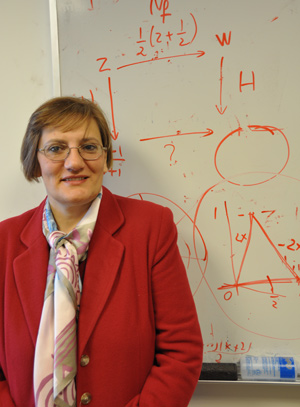
Photo by Gina Vergel
Melkana Brakalova’s first teaching experience came as a 17-year-old in Bulgaria, when she set out to make a few extra levas tutoring math, her favorite subject.
“I didn’t have the goal of teaching, but I loved the challenge of working with a person who didn’t understand math and seeing them reach this ‘a-ha’ moment,” said Brakalova, Ph.D., assistant professor of mathematics.
Today, she boasts extensive experience teaching advanced mathematics in higher education and a lengthycurriculum vitae featuring academic research into geometric function theory and the Beltrami equation. She has published research in dozens of leading mathematics journals, including theAnnales of the Finnish Academy of Sciences, and Journal of Mathematical Analysis (Israel). In recent years, Brakalova won a faculty fellowship and three faculty research grants from Fordham in support of her research, some of which led to collaboration with mathematicians from Finland, Switzerland and Israel.
Yet mathematics education is still very much part of her life.
She has held visiting postdoctoral positions at the University of Minnesota, Washington University, Stony Brook University and completed a short stint teaching mathematics at a private boarding school in Connecticut. Brakalova spent her early years at Fordham involved in an undergraduate mathematics education program in conjunction with the Graduate School of Education (GSE). The melding of math research and math education—while, at times, challenging—is still very much a passion and a puzzle for her.
“There are very few mathematicians who have gone from mathematics to math education in an attempt to influence the way that it is taught,” she said. “This is a huge issue of interest to me. I hope to combine my mathematics knowledge with education to produce articles on the topic.”
For Brakalova, the challenge lies in the way most math teachers are educated in the United States. Typically, they earn an undergraduate degree in math, and later a graduate degree in math education, with a curriculum that focuses on pedagogy.
“This is a central question of education for me: Should I teach somebody how to teach, or teach somebody the content? Where we lack strength is that content has been sacrificed for the sake of pedagogy,” Brakalova said.
“There is this divorce between the two sides,” she added, referring to the mathematics and the math education camps that exist in academia.
Since Brakalova is experienced in both worlds, she was able to assist on a three-year project that encouraged high school math teachers to examine how they use discourse in their instruction. The study, funded by the National Science Foundation, was led by Rita Kabasakalian, Ph.D., a professor and researcher at GSE.
“It was an enlightening experience for us,” Brakalova said. “We sat in on ninth- and tenth-grade math classes, trying to find out where the confusion arises if someone is teaching a topic: Are they understanding the topic completely? Are they relying on enough information and resources to present it so that more students relate to that topic?”
Brakalova relished “getting into the minds of teachers and students about the language of mathematics and how that language is transformed.”
Throughout the project, the researchers found that sometimes students are embarrassed to ask questions. Sometimes teachers don’t know what is getting through to the students.
Using an appropriate discourse—encouraging students to speak and building instruction around what they say, understand and think—is an example of strengthening mathematics lessons.
“This is part of the process of teaching—to open mathematics to people who think they are not good at it,” Brakalova said. “But if the teacher isn’t fully knowledgeable on advanced concepts, this can pose problems. Unfortunately, in many cases, the major source for a math teacher is the textbook.”
For example, if a teacher is teaching linear equations or related algebraic topics, but doesn’t have a solid understanding of polynomials, rings and fields, he or she may have difficulty connecting with students. That is why there should be courses at the undergraduate level that are aimed at—and designed for—teachers, so that they can teach and understand math at a deeper level, Brakalova said.
“The typical undergraduate math curriculum was created to serve future engineers, as well as to prepare students for a lot of professions—accounting, physics, biology, chemistry, math, law, the health professions and so forth,” she said, “but we don’t have enough courses that address elementary mathematics from an advanced standpoint that would build a base broad and strong enough for teachers.”
Were it up to Brakalova, she would create courses for those who intend to teach K-12 that would address relevant elementary mathematics from an advanced point of view.
“A lot of fun yet difficult math can be done with elementary concepts,” she said. “An example of this is geometry, where you manipulate and relate simple concepts such as segments, triangles and circles to create a universe that is really difficult yet beautiful.”
Though her passion for the subject is obvious, Brakalova admitted that mathematics education is a minor part of her published work and her active research.
“I really feel it is a puzzle,” she said. “A broader impact would be reached if we could create a program that could serve teachers in directions we think are underrepresented. Content would be a great place to start.”
For now, Brakalova is working with the Department of Computer Science to create an advanced certificate program in math content and information sciences for educators.
“We are trying to create a program for teachers who are really interested in enhancing their skills and learning more advanced mathematics and computer sciences,” Brakalova said. “Let’s make it a program of the future, not of the past.”
